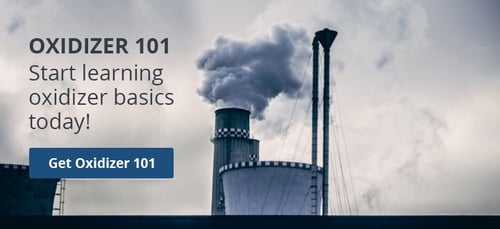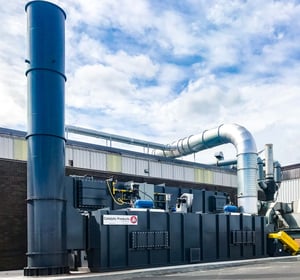What are the features of a Regenerative Thermal Oxidizer?
Catalytic Products International has been designing, manufacturing, and installing the world's most innovative thermal oxidizers since 1969. Throughout our long history, we continually strive to offer the most advanced air pollution control equipment. These constant efforts have led us to the development of the CPI Regenerative Thermal Oxidizer (RTO). Each system is custom engineered to exceed all worldwide air compliance guidelines at the lowest overall costs.
CPI RTOs offer innovative design characteristics:
Modular Generator technology
 CPI RTOs are custom designed for the highest reliability with the lowest overall costs. The complete system is designed with a modular approach for the most cost-efficient solution. The typical CPI RTO is supplied as a 2-tower regenerator system fitted to our EvenFlo Valve Manifold. This modular approach satisfies your needs for a competitive installation cost and ensures that the Posi-Seal valves are properly installed and aligned prior to leaving the factory.
CPI RTOs are custom designed for the highest reliability with the lowest overall costs. The complete system is designed with a modular approach for the most cost-efficient solution. The typical CPI RTO is supplied as a 2-tower regenerator system fitted to our EvenFlo Valve Manifold. This modular approach satisfies your needs for a competitive installation cost and ensures that the Posi-Seal valves are properly installed and aligned prior to leaving the factory.
Cold Face Support
 Complementing the regenerator design is our unique cold face support system. While other systems merely rely on a perforated plate to support the ceramic media, CPI RTO systems use a superior supporting grid that allows the lowest pressure drops and highest structural integrity. Based on the application needs, the CPI RTO can be supplied with stainless steel metallurgy to resist chemical attack or added thermal stresses.
Complementing the regenerator design is our unique cold face support system. While other systems merely rely on a perforated plate to support the ceramic media, CPI RTO systems use a superior supporting grid that allows the lowest pressure drops and highest structural integrity. Based on the application needs, the CPI RTO can be supplied with stainless steel metallurgy to resist chemical attack or added thermal stresses.
Posi-Seal Valves
 Posi-Seal valves are designed to take advantage of a vertical axis that allows for soft seating action with self-centering guidance. The innovative feature of all Posi -Seal valves is the air-tight machined seal that eliminates valve bypass and maintenance-intensive gaskets. The Posi-Seal valve will be pneumatically operated and will cycle open or closed based on the program logic called for in your application.
Posi-Seal valves are designed to take advantage of a vertical axis that allows for soft seating action with self-centering guidance. The innovative feature of all Posi -Seal valves is the air-tight machined seal that eliminates valve bypass and maintenance-intensive gaskets. The Posi-Seal valve will be pneumatically operated and will cycle open or closed based on the program logic called for in your application.
Posi-Seal Shaft Cooling
 CPI RTO systems incorporate shaft and bearing cooling systems. This simple yet often overlooked feature provides a cool supply of air in the bearing tube and on the bearings. This prevents leakage of the higher pressure air on the inside of the oxidizer from escaping to the atmosphere and helps cool the shaft and bearings for long life.
CPI RTO systems incorporate shaft and bearing cooling systems. This simple yet often overlooked feature provides a cool supply of air in the bearing tube and on the bearings. This prevents leakage of the higher pressure air on the inside of the oxidizer from escaping to the atmosphere and helps cool the shaft and bearings for long life.
Internal Isolation Systems
 The CPI RTO is internally insulated with ceramic insulating modules. This system provides low shell temperatures and helps to retain heat for improved efficiency.
The CPI RTO is internally insulated with ceramic insulating modules. This system provides low shell temperatures and helps to retain heat for improved efficiency.
EvenFlo Manifold Insulation
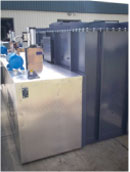 In some cases, the EvenFlo Manifold can be insulated to ensure that the pollutants that enter the oxidizer remain in a gaseous state. If the process constituents should condense at some point in the oxidizer, they can become a maintenance issue or worse yet, become a hazard to the equipment. Some pollutants will condense and collect on many of the surfaces of the oxidizers, leaving a sticky, tarry substance that is difficult to remove. Insulating our EvenFlo Manifold helps to prevent any condensation, and keeps your process air in a gaseous state.
In some cases, the EvenFlo Manifold can be insulated to ensure that the pollutants that enter the oxidizer remain in a gaseous state. If the process constituents should condense at some point in the oxidizer, they can become a maintenance issue or worse yet, become a hazard to the equipment. Some pollutants will condense and collect on many of the surfaces of the oxidizers, leaving a sticky, tarry substance that is difficult to remove. Insulating our EvenFlo Manifold helps to prevent any condensation, and keeps your process air in a gaseous state.
Thermal Heat Transfer Ceramic Media
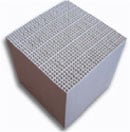 Each CPI Regenerative Thermal Oxidizer system is designed around the particular ceramic heat transfer matrix recommended for the application. CPI RTO systems can be designed using a layered structural ceramic media or a mix of structured and random media (saddles), depending on your application's requirements. The thermal heat transfer model is the key to a well designed and efficient system. With thermal rate efficiencies (TRE) ranging from 85 percent to 97 percent, you can be assured that even the lowest VOC concentrations can be economically destroyed.
Each CPI Regenerative Thermal Oxidizer system is designed around the particular ceramic heat transfer matrix recommended for the application. CPI RTO systems can be designed using a layered structural ceramic media or a mix of structured and random media (saddles), depending on your application's requirements. The thermal heat transfer model is the key to a well designed and efficient system. With thermal rate efficiencies (TRE) ranging from 85 percent to 97 percent, you can be assured that even the lowest VOC concentrations can be economically destroyed.
The CPI RTO also employs a bake-out feature that will allow periodic high temperature cleaning of condensate residue from the lower levels of the ceramic media beds and cold face support.
Learn more about RTO media maintenance and design by clicking here: RTO Ceramic Media and Maintenance
Temperature Safety Systems
 Every CPI RTO system is integrated with our customized programmable logic controller PLC-control panel called Temperature Safety System (TSS) Control. TSS communicates with the CPI RTO system and your process for optimal performance, safety and reliability. We use our proprietary thermal control logic and multiple temperature inputs to maximize the regenerator's thermal efficiency. This unique control technique constantly adjusts valve timing to maximize thermal efficiency without compromise in destruction efficiency. No other supplier goes to these extremes to maximize the performance of their RTO.
Every CPI RTO system is integrated with our customized programmable logic controller PLC-control panel called Temperature Safety System (TSS) Control. TSS communicates with the CPI RTO system and your process for optimal performance, safety and reliability. We use our proprietary thermal control logic and multiple temperature inputs to maximize the regenerator's thermal efficiency. This unique control technique constantly adjusts valve timing to maximize thermal efficiency without compromise in destruction efficiency. No other supplier goes to these extremes to maximize the performance of their RTO.
Extensive Materials Selection
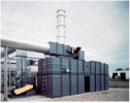 Metallurgical conformity and assessment process to ensure corrosion, and thermally resistant materials are used throughout the regenerative thermal oxidizer system.
Metallurgical conformity and assessment process to ensure corrosion, and thermally resistant materials are used throughout the regenerative thermal oxidizer system.
Complete Shop Assembly
 A drop-in-place installation has proven to be highly desirable. For some sizes this includes media loading, pre-wiring and extensive I/O quality control that ensures the control system is ready to operate.
A drop-in-place installation has proven to be highly desirable. For some sizes this includes media loading, pre-wiring and extensive I/O quality control that ensures the control system is ready to operate.
Back to RTO questions

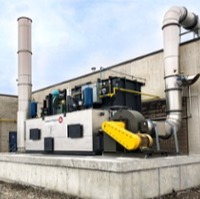
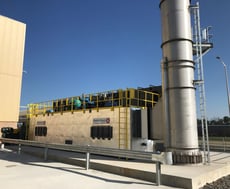
.jpg?width=869&name=How%20an%20RTO%20Works%20(no%20text).jpg)
 CPI RTOs are custom designed for the highest reliability with the lowest overall costs. The complete system is designed with a modular approach for the most cost-efficient solution. The typical CPI RTO is supplied as a 2-tower regenerator system fitted to our EvenFlo Valve Manifold. This modular approach satisfies your needs for a competitive installation cost and ensures that the Posi-Seal valves are properly installed and aligned prior to leaving the factory.
CPI RTOs are custom designed for the highest reliability with the lowest overall costs. The complete system is designed with a modular approach for the most cost-efficient solution. The typical CPI RTO is supplied as a 2-tower regenerator system fitted to our EvenFlo Valve Manifold. This modular approach satisfies your needs for a competitive installation cost and ensures that the Posi-Seal valves are properly installed and aligned prior to leaving the factory. Complementing the regenerator design is our unique cold face support system. While other systems merely rely on a perforated plate to support the ceramic media, CPI RTO systems use a superior supporting grid that allows the lowest pressure drops and highest structural integrity. Based on the application needs, the CPI RTO can be supplied with stainless steel metallurgy to resist chemical attack or added thermal stresses.
Complementing the regenerator design is our unique cold face support system. While other systems merely rely on a perforated plate to support the ceramic media, CPI RTO systems use a superior supporting grid that allows the lowest pressure drops and highest structural integrity. Based on the application needs, the CPI RTO can be supplied with stainless steel metallurgy to resist chemical attack or added thermal stresses. Posi-Seal valves are designed to take advantage of a vertical axis that allows for soft seating action with self-centering guidance. The innovative feature of all Posi -Seal valves is the air-tight machined seal that eliminates valve bypass and maintenance-intensive gaskets. The Posi-Seal valve will be pneumatically operated and will cycle open or closed based on the program logic called for in your application.
Posi-Seal valves are designed to take advantage of a vertical axis that allows for soft seating action with self-centering guidance. The innovative feature of all Posi -Seal valves is the air-tight machined seal that eliminates valve bypass and maintenance-intensive gaskets. The Posi-Seal valve will be pneumatically operated and will cycle open or closed based on the program logic called for in your application. CPI RTO systems incorporate shaft and bearing cooling systems. This simple yet often overlooked feature provides a cool supply of air in the bearing tube and on the bearings. This prevents leakage of the higher pressure air on the inside of the oxidizer from escaping to the atmosphere and helps cool the shaft and bearings for long life.
CPI RTO systems incorporate shaft and bearing cooling systems. This simple yet often overlooked feature provides a cool supply of air in the bearing tube and on the bearings. This prevents leakage of the higher pressure air on the inside of the oxidizer from escaping to the atmosphere and helps cool the shaft and bearings for long life. The CPI RTO is internally insulated with ceramic insulating modules. This system provides low shell temperatures and helps to retain heat for improved efficiency.
The CPI RTO is internally insulated with ceramic insulating modules. This system provides low shell temperatures and helps to retain heat for improved efficiency. In some cases, the EvenFlo Manifold can be insulated to ensure that the pollutants that enter the oxidizer remain in a gaseous state. If the process constituents should condense at some point in the oxidizer, they can become a
In some cases, the EvenFlo Manifold can be insulated to ensure that the pollutants that enter the oxidizer remain in a gaseous state. If the process constituents should condense at some point in the oxidizer, they can become a  Each CPI Regenerative Thermal Oxidizer system is designed around the particular ceramic heat transfer matrix recommended for the application. CPI RTO systems can be designed using a layered structural ceramic media or a mix of structured and random media (saddles), depending on your application's requirements. The thermal heat transfer model is the key to a well designed and efficient system. With
Each CPI Regenerative Thermal Oxidizer system is designed around the particular ceramic heat transfer matrix recommended for the application. CPI RTO systems can be designed using a layered structural ceramic media or a mix of structured and random media (saddles), depending on your application's requirements. The thermal heat transfer model is the key to a well designed and efficient system. With  Every CPI RTO system is integrated with our customized programmable logic controller PLC-control panel called Temperature Safety System (TSS) Control. TSS communicates with the CPI RTO system and your process for optimal performance, safety and reliability. We use our proprietary thermal control logic and multiple temperature inputs to maximize the regenerator's thermal efficiency. This unique control technique constantly adjusts valve timing to maximize thermal efficiency without compromise in destruction efficiency. No other supplier goes to these extremes to maximize the performance of their RTO.
Every CPI RTO system is integrated with our customized programmable logic controller PLC-control panel called Temperature Safety System (TSS) Control. TSS communicates with the CPI RTO system and your process for optimal performance, safety and reliability. We use our proprietary thermal control logic and multiple temperature inputs to maximize the regenerator's thermal efficiency. This unique control technique constantly adjusts valve timing to maximize thermal efficiency without compromise in destruction efficiency. No other supplier goes to these extremes to maximize the performance of their RTO. Metallurgical conformity and assessment process to ensure corrosion, and thermally resistant materials are used throughout the regenerative thermal oxidizer system.
Metallurgical conformity and assessment process to ensure corrosion, and thermally resistant materials are used throughout the regenerative thermal oxidizer system. A
A 
